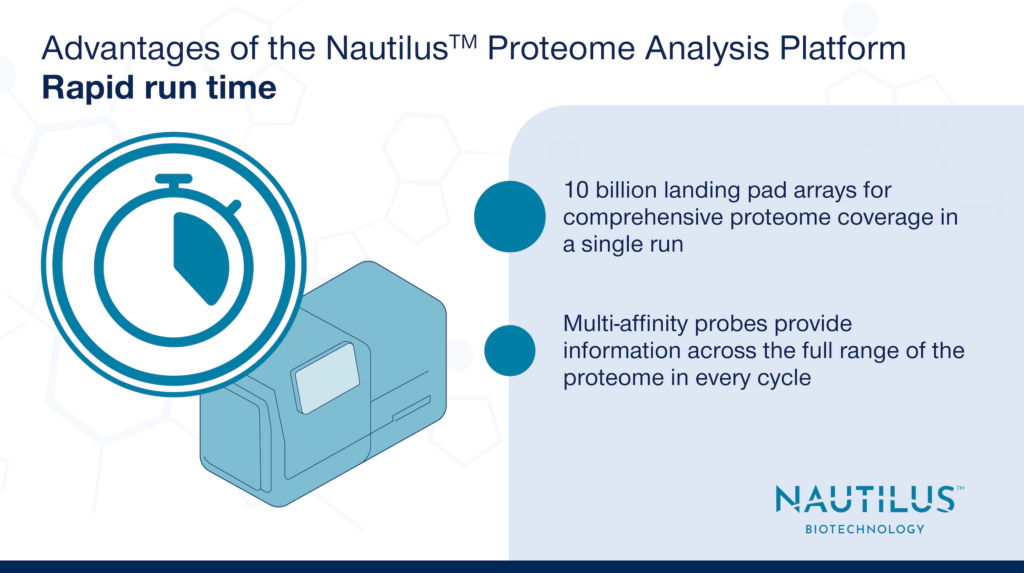
Advantages of the Nautilus Proteome Analysis Platform – Rapid run time

Tyler Ford
February 15, 2024

When conducting proteomic analyses of many samples, it can take days to weeks to cover only a fraction of the proteome in every sample. Multiplexing techniques can speed things up, but the traditional proteomic workhorse, mass spectrometry, still must analyze peptides sequentially leading to long run times. Preprocessing techniques that result in greater proteome coverage increase run time even further.
Recognizing the burden long run times place on researchers as well as institutional resources, we’ve designed the NautilusTM Proteome Analysis Platform with rapid run time as a core attribute. Read on to learn about the platform’s key characteristics designed to make it capable of rapidly quantifying substantively all of the proteome.
Key characteristics designed to give the NautilusTM Platform rapid run time
10-billion landing pad single-molecule protein arrays
The arrays we use to scaffold single protein molecules on the Nautilus Platform contain 10-billion single-molecule landing pads. This means the platform is designed to analyze up to 10-billion proteins at once. This will enable researchers to quantify substantively all of the proteome in a sample. On other platforms, multiple runs with different parameters or reagents are generally required to achieve this level of coverage.
Multi-affinity probes provide information across the full range of the proteome in every cycle
We identify proteins on our platform through massively parallel, iterative cycles of multi-affinity probe binding. Our multi-affinity probes are designed to bind 3 amino acid epitopes shared across many proteins. Both binding and non-binding events provide information to our machine learning algorithm and make it possible to identify substantively all proteins in the proteome with ~300 probes. The relatively small number of probes required compared to the number of proteins identified (~20,000 for the human proteome) should enable our platform to efficiently quantify full proteomes.
Learn more about our multi-affinity probe-based protein identification methodology, Protein Identification by Short epitope Mapping (PrISM) and watch this animation for a visual dive into the protein quantification process:
Rapid proteome analysis for rapid insight generation
The more samples researchers can assess with comprehensive proteomic analyses, the easier it will be for them to identify significant differences between samples and controls. Thus, decreasing the time it takes to go from sample to result can accelerate insight generation across many kinds of experiments. Future platform enhancements may accelerate run times further through multiplexing and other strategies. It is our hope that the platform’s rapid run time will make it possible for researchers to bridge the gap between proteome and phenotype more quickly than ever before and accelerate advances in cancer research, neuroscience research, drug development, and more.
MORE ARTICLES
